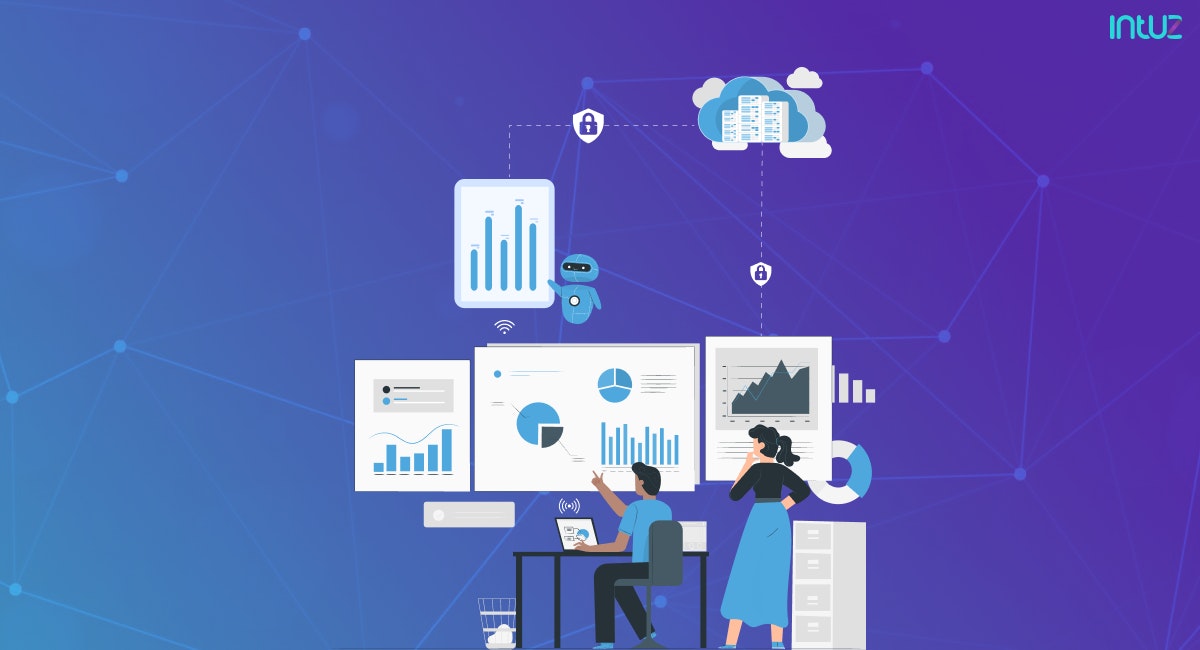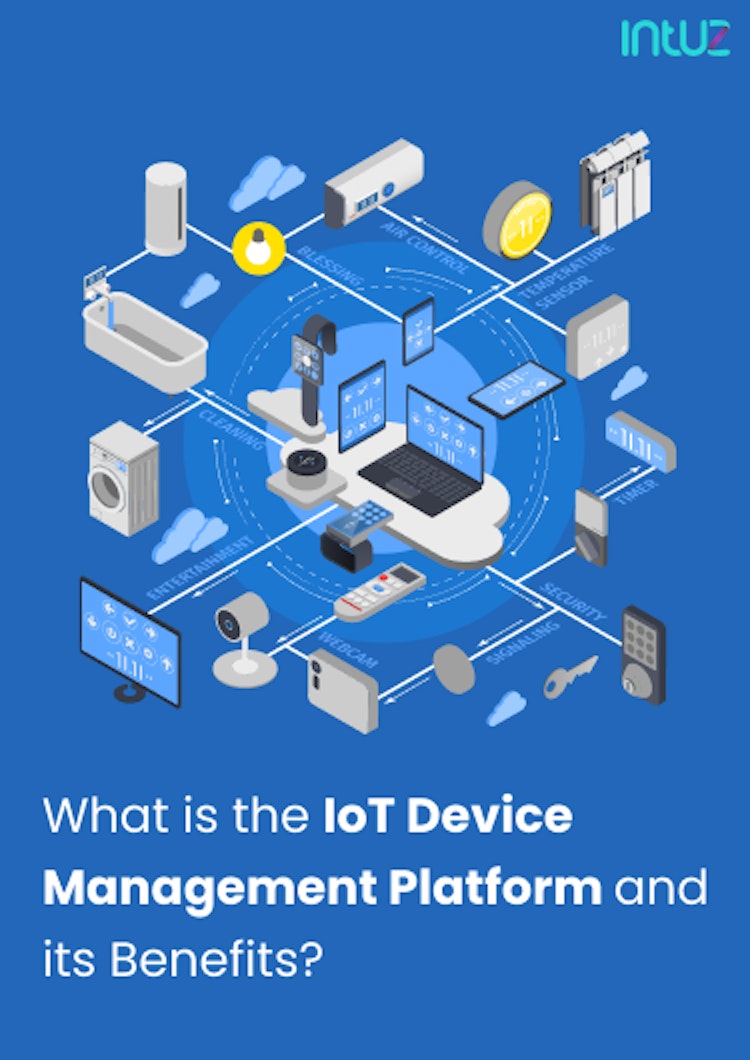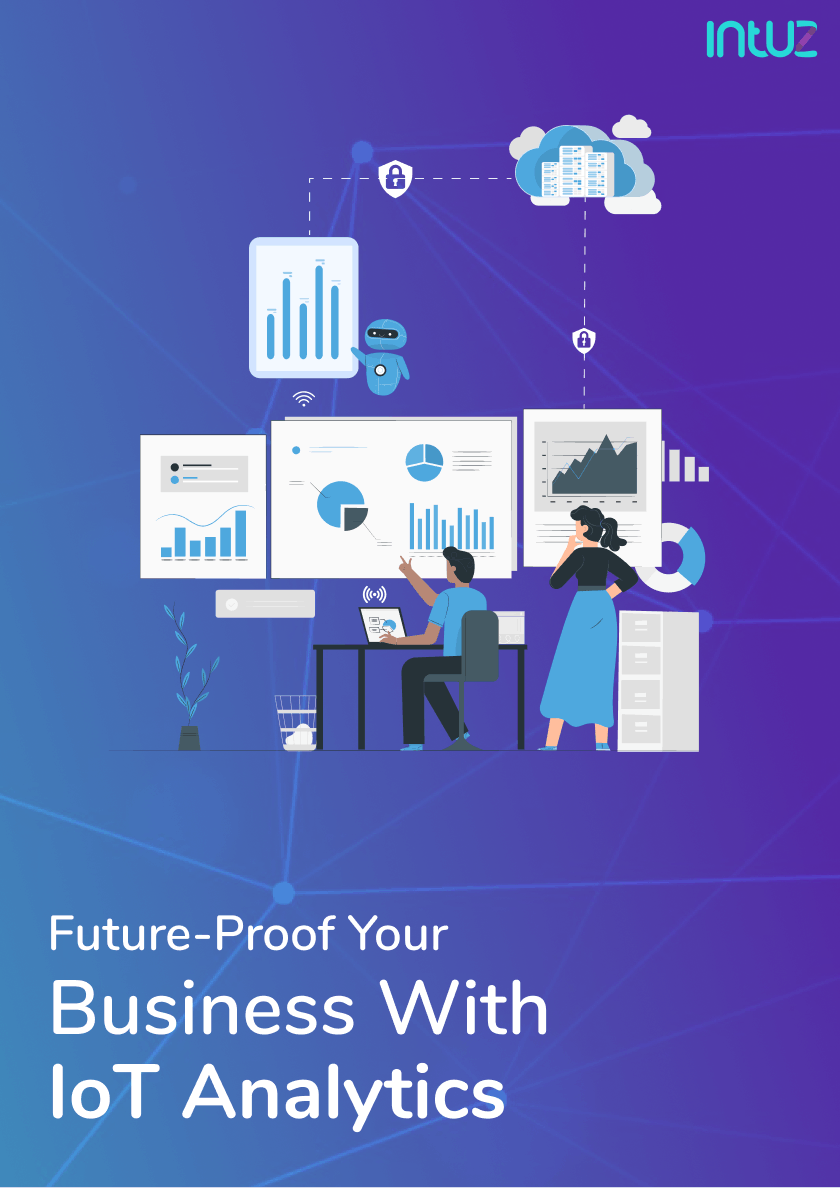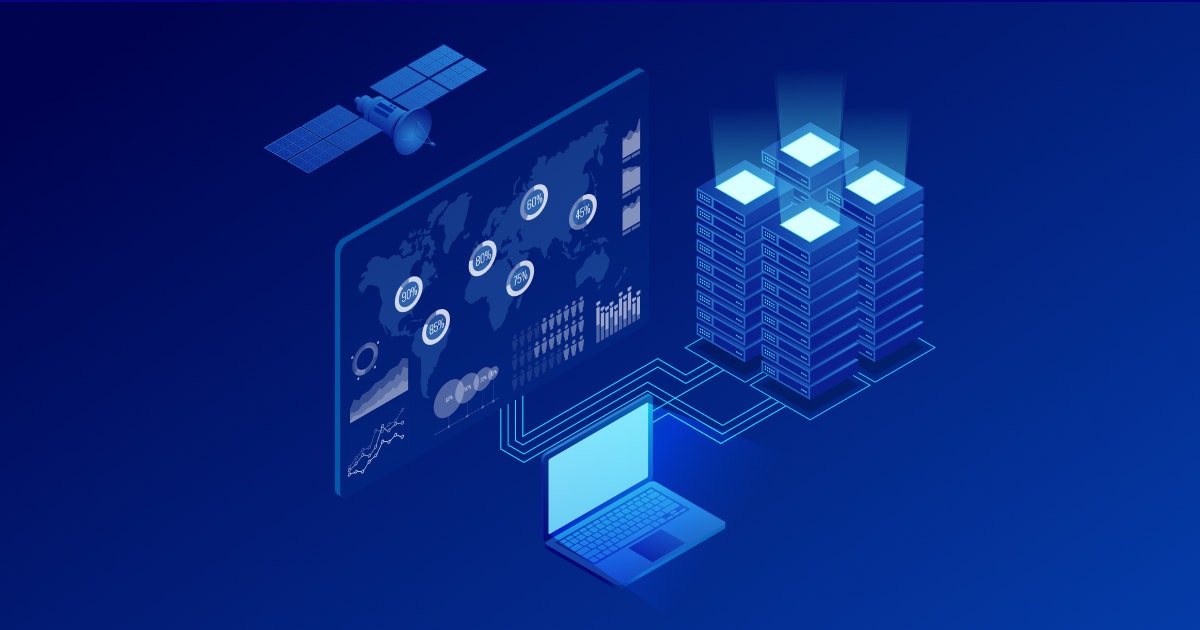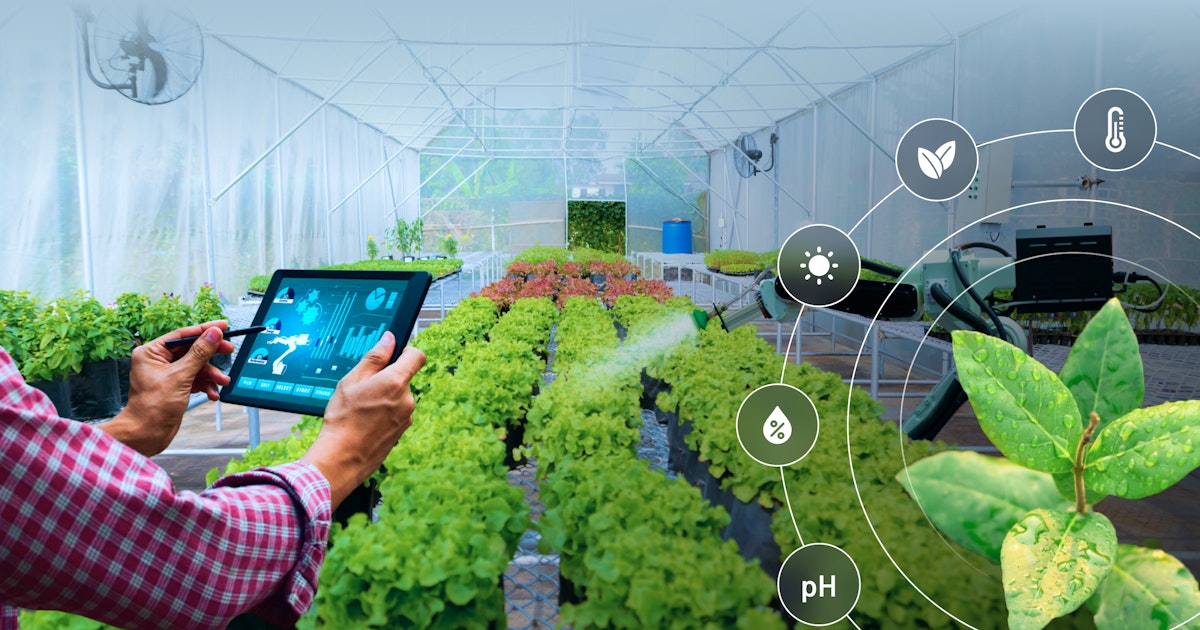Table of Content
The adoption of the Internet of Things (IoT) has been on the rise, and the total number of IoT connections is expected to reach 83 billion by 2024, a massive jump from only 35 billion connections in 2020.
As the number increases, so does the struggle of companies to handle massive amounts of generated data. Unfortunately, the data transmitted amongst IoT devices is less structured and more complicated to manage.
That is where complex analytics enters the picture. It refers to the process of interpreting and extracting valuable insights from large data sets. With 13.8 billion IoT devices constantly gathering data worldwide, IoT analytics has found a purpose in data organization and usage.
As one of the top four technologies expected to impact organizations across industries, the adoption and deployment of IoT technology will only increase manifold.
In this guide, we will look at how to develop and implement IoT analytics for better running your business. But first, let us start with the basics:
What is IoT analytics?
IoT analytics involves applying data analysis tools and procedures for realizing value from vast amounts of data gathered by an IoT network. These tools can improve business processes by optimizing your IoT device's performance by diagnosing and fixing issues early on.
However, the most common and productive use case of IoT analytics is to provide insights into your operations and ease data-driven decision-making. IoT analytics has also carved a niche for itself in industrial automation.
Industrial IoT or IIoT refers to the data collected from sensors present in manufacturing infrastructure such as machinery, factory units, and modules. It can also include other high-volume deployments - from weather stations and smart utility meters to delivery trucks.
The IoT technology is fast revolutionizing data management across all domains and powering applications in handling retail, healthcare, and oil and gas industries.
In the case of IIoT, sophisticated analytics gives operation controllers the power to remotely observe their equipment in real-time and make changes before it malfunctions.
In many ways, Big Data and IoT analytics seem similar at first glance. However, key differences exist between the two concepts concerning the volume of data and their origins.
The data integration process is complex, but it can be easier with the right tools. There are different sources of information on IoT, and they all need to come together and form one stream that makes sense for businesses to leverage.
Devices that power IoT analytics
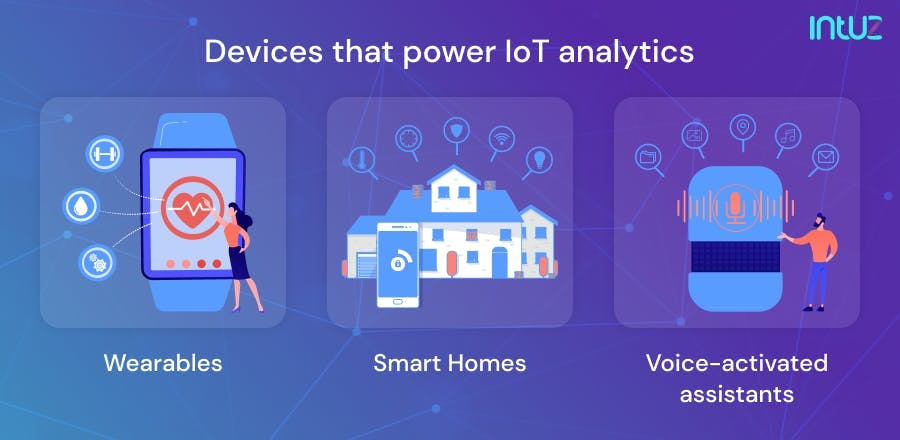
Devices that power IoT analytics
IoT devices are hardware devices, such as gadgets, sensors, and appliances, that collect and exchange data over the internet. They are programmed for specific IoT apps and can be embedded into other IoT devices, including:
1. Wearables
The new wave of fitness trackers has gone beyond just tracking your steps. You can now keep tabs on your physical regime and the health of your friends and family and compete with them through messaging or calling them via the IoT device connection.
The user data is collected by the devices and tracked by fitness companies. They use it to create customized workout packages or nutrition plans if you use their services.
For instance, depending upon your vitals, they can put together an exercise routine tailored for you, prepare a meal chart, and help you achieve your weight goals. Insights help in content creation and the correct delivery of dataset contents.
The wearables work as a utility item for maintaining your health and fitness as they are enabled with features that include heart rate and sleep monitoring capabilities.
2. Smart homes
Who does not want to live in a smart home? Imagine if you could switch off the lights in your kitchen while getting ready to hit the bed? Smart homes have systems that can be accessed and controlled remotely.
The technology includes alarm and security systems, entertainment products, and smart appliances. These could be powered on or off remotely using your phone or tablet. Again - large volumes of data are collected from these IoT devices to assess usage patterns and improve the efficacy of a smart home.
Companies are always looking to improve their product returns by syncing with consumer needs. An edge IoT analytics platform allows them to monitor how people use their devices and identify the scope of improvement.
3. Voice-activated assistants
A form of IoT device, digital assistants are now becoming a part of our daily lives. They can do everything - from taking notes for us to playing music while also forecasting the weather. The regular updates of voice systems help improve their functionality.
These little bots have become popular in recent years because they offer personalized services based on our everyday interactions with them. Data from these devices help companies personalize their services based on customer interest.
Diving deeper into IoT analytics: Top technologies and features
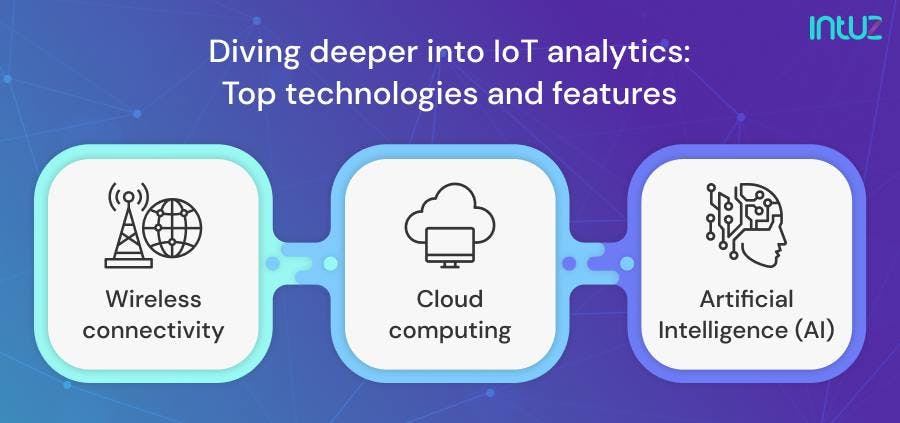
IoT analytics: Top technologies and features
IoT analytics can help you analyze data from all IoT connected devices without requiring any hardware or infrastructure. As the organizational needs evolve, computing power and data storage have to be scalable.
That ensures IoT analysis can be undertaken even when the load from the IoT devices is at an all-time high. Here are the top technologies in an IoT ecosystem:
1. Wireless connectivity
Wireless sensors have made it possible to sense and transmit any machine parameter without wired connections. This is accomplished through cellular or Wi-Fi connectivity, which automatically collects data from these devices, saving time and money.
Sensing has become more accessible and less expensive with the smartphone revolution. Miniaturized MEMS sensors are now readily available at a lower cost.
2. Cloud computing
Industrial plants can now start small and scale up as their needs increase with the help of cloud computing. The advanced technology offers robust, highly secure, and inexpensive data storage and computing capabilities.
3. Artificial Intelligence (AI)
AI is among the most popular technologies globally, coupled with IoT, and its wider adoption has made it mainstream. Since manual monitoring of time-series sensor data is impossible, AI assists analysts in advanced processing.
How IoT analysis takes place
- The most critical aspect of IoT analysis is data collection. The first thing you need to do is collect data from various sources, formats, and frequencies.
- All data sets are transformed and enriched by external sources. It helps organize raw data into meaningful datasets.
- Different types of information are combined and processed with a wide range of external sources.
- The processed data is time-stamped and stored in a time-series data store. This step ensures the required information is readily available for analysis. Information is stored in a time series for future analysis.
- The most crucial step of the process is analysis. It involves running data through SQL queries or pre-built templates. Machine learning models may perform custom analysis, and the insights are used to make business predictions.
- The results of the analysis can be used to make various predictions. Customized systems, standard SQL queries, and machine learning techniques are viable options for obtaining information to help you in your business endeavors.
- Companies can build several systems to make their business processes easier using the information received. The reports generated by the prescriptive analytics process help build mobile applications and business systems.
Business use cases of IoT analytics
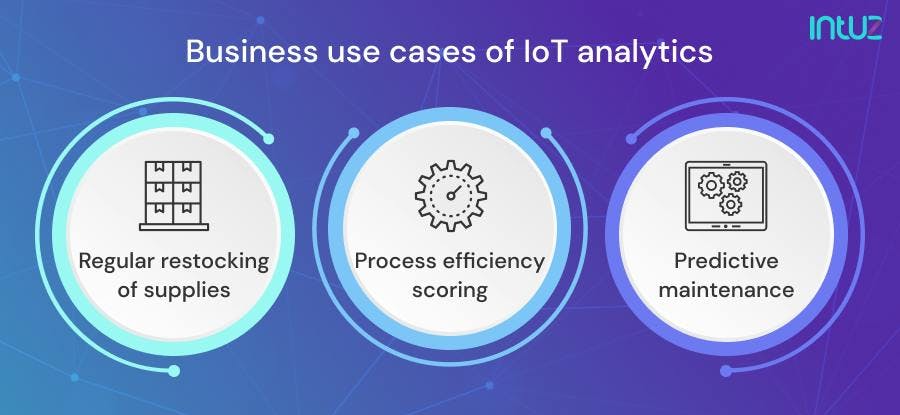
Business use cases of IoT analytics
Since IoT-powered devices gather data sets in huge quantities, organizations can use the same to enable informed decision-making and achieve operational efficiency. It is, therefore, essential to process the data in a structured fashion. Here are the top examples to know about:
1. Regular restocking of supplies
The authority managing connected vending machines in a particular setting can be made aware of the inventory levels in real-time and request restocking when needed. This is enabled by connecting the machines with other recipient systems.
The IoT devices share data on stock availability and requirements. An order is placed when an alert is triggered for restocking inventory. The use of AWS IoT Analytics can help businesses monitor their inventories in real-time.
For example, a company that sells food and drink could use AWS IoT Analytics to understand when supplies on one machine run low. They will not only know inventory status ahead of time but can track customer requests for specific items and ensure the availability of stock.
2. Process efficiency scoring
IoT analytics is a powerful concept that can be used to streamline and improve every aspect of your company's processes. The data generated in the IoT ecosystem has the potential to identify current bottlenecks and point out areas where change might be needed with efficiency for improvements. IoT analysis helps your team work smarter rather than harder.
Companies can use AWS IoT Analytics to build end-user applications that monitor the efficiency of different processes and help them improve operations. For example, a mining company could use AWS IoT Analytics to optimize the performance of its ore trucks by monitoring their loads.
The firm can compare any deviations from target conditions in real-time. It can plan guidelines for loads carried by different trucks across locations. It will result in increased productivity through better-utilized resources in the long term.
3. Predictive maintenance
Different infrastructure has varying maintenance needs. IoT analytics examines each connected component against pre-set templates. The data gathered can help determine the quality of predictive maintenance models and their application for specific requirements.
For example, IoT diagnostic analytics can determine the condition of a vehicle in long-distance transport vehicles with heating and cooling systems.
If you use a tool like AWS IoT Analytics, it can alert the business owner or the concerned authority when a vehicle needs an overhaul to minimize downtime and ensure cargo is not damaged.
Creating predictive maintenance models and applying them across your fleet could help you avoid costly damages. You could easily build a model that predicts repair and maintenance requirements by using AWS IoT Analytics.
For instance, AWS IoT Analytics helps you predict when heating and cooling systems will fail on connected cargo vehicles. You can prevent shipment damage by serving the fleet's needs before they arise, avoiding interruption in delivery schedules due to unnecessary repairs or downtime.
Benefits of IoT analytics
With IoT analytics, you can gain invaluable insights. These action items can result in:
- Better visibility and control of the business, which, in turn, improves decision-making. You can make a faster critical assessment when you have data at your fingertips.
- By scaling your business according to evolving consumer demands and industry developments, you can improvise your offerings and deliver a better service.
- Automation can help reduce operational costs by improving resource utilization. You can also easily find new revenue streams resulting from eliminating operational challenges from the mix. IoT analysis ensures quick and accurate detection of problems.
- To deliver the best possible customer experience, you must study their purchase history and identify buying patterns. This is made possible with robust analysis.
Market statistics related to IoT
According to Mordor Intelligence, the IoT analytics market is expected to grow at a CAGR of 29.8%, reaching $81.67 billion by 2026 from $17.14 billion in 2020. The market statistics indicate the following.
- Ericcson's mobility report predicts the number of IoT devices with cellular connections will be 1.5 billion in 2022. This rapidly growing number of connected edge devices is among the prominent factors driving the growth of the IoT analytics market.
- The industrial sector is riding high on its automation trend, and manufacturers are turning to IoT analytics for streamlining factory operations. They use a network of robots and sensors that provide data for automating processes and making better decisions.
- The data compiled by the International Federation of Robotics shows that around 2,300 robots were active in the UK in 2019, a rise of 30% in a year. This trend hints at an optimistic future for IoT analytics markets, as their demand may boost significantly.
- The IoT analytics market is expected to grow through strategic partnerships alongside implementing the technology on a larger scale. A stronger foothold of prominent players in the market will fuel innovation. For example, the partnership between SAS, a global leader in IoT analytics, and Octo Telematics is something to watch out for.
IoT trends to watch out for
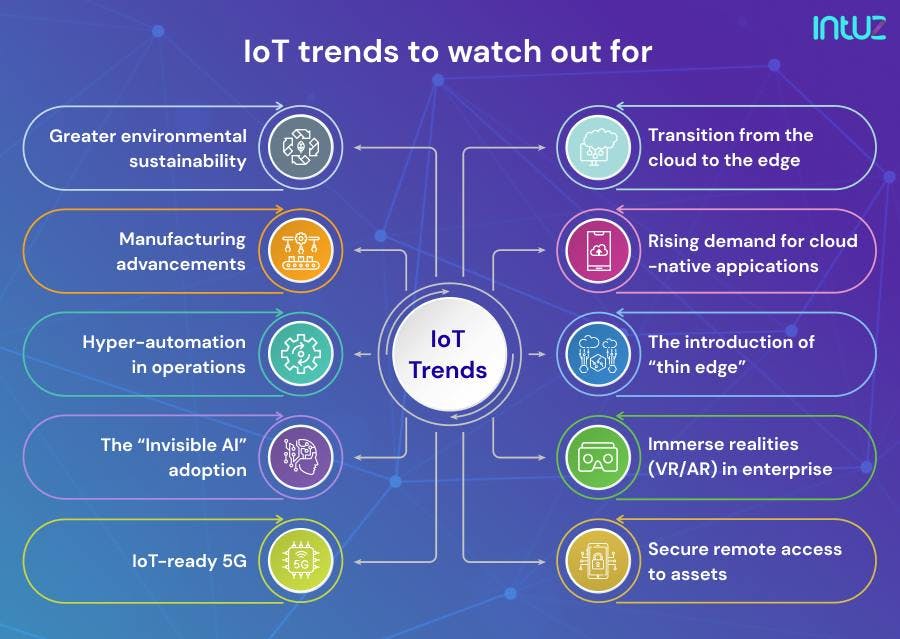
IoT trends to watch out for
There is no doubt that IoT devices can execute much more complex tasks, generate vast amounts of relevant data, and facilitate better data analytics to improve automation and reduce errors. Here are the top IoT trends to watch out for in 2022 and beyond:
1. Greater environmental sustainability
Smart connected devices have the potential to be an essential part of our future. They can help us monitor environmental conditions, manage equipment remotely, and optimize energy. The business value of the apps may be limited currently, but there is hope on the horizon.
In a world where we are all looking for ways to be sustainable, IoT technology can enable green solutions across industry niches. The rising focus on building green economies and mitigating climate change justifies why IoT applications are the need of the hour.
The IoT technology is a crucial component in pushing toward an environmentally sustainable global economy. It has already been instrumental in reducing energy costs, enabling remote monitoring and deployment of failure points. The future is bright!
2. Transition from the cloud to the edge
There is no doubt that IoT technology has taken off significantly, and many leaders have emerged among IoT platforms in recent years.
Edge platforms specifically for industrial use cases are predicted to become more mature by 2022 as competitors try to distinguish themselves from other players.
VMs, containers, and other virtualization technologies make it possible to run IoT applications on different types of hardware.
The process does not involve an app change, thereby enabling IT departments to quickly move an app away from one machine with less power, memory, or processing capabilities over time.
The edge platform vendors support different cloud platforms and IoT solutions, hardware, and edge applications.
3. Manufacturing advancements
The role of IoT in the future will go beyond Supervisory Control and Data Acquisition (SCADA). It will support manufacturing professionals by supplying data needed for timely decisions about maintaining critical assets.
This will help engineers solve problems such as machine failures with greater efficiency and accuracy. IIoT organizations will no longer only digitize their processes but also benefit from data-driven decision-making thanks to the technology.
4. Rising demand for cloud-native applications
Cloud computing is no longer an intelligent choice for businesses; it is a necessity. No wonder many companies are looking to adopt this new technology rapidly - irrespective of their business size or industry niche.
Businesses that have already heavily invested in cloud-native apps will need new ways to drive maximum efficiency while others are rapidly migrating to it.
The cloud market has grown steadily in the last decade, but its adoption accelerated with the onset of the COVID-19. In the future, we will see a whole new generation of applications that are specifically optimized for reaching a desired state of performance.
This means they can be deployed faster with greater reliability, helping reduce time to market. It also helps control costs and infrastructure complexities.
5. Hyper-automation in operations
AI requires you to dig data deeply before it can help your company. A virile combination of AI and Robotic Process Automation (RPA) has led to a new efficiency level, bringing us one step closer to achieving hyper-automation.
The pandemic was the turning point as organizations prioritized worker safety and used technology to support them. Hyper-automation helped handle the situation as industries were already dealing with ongoing labor shortages long before the pandemic started.
6. The introduction of “thin edge”
Until now, companies have run on high-powered computers and routers that sit at the edge, but the following two trends may change this:
- Semiconductors, especially at the lower-cost, lower power-end of the spectrum, are integrated with AI capabilities. As AI gets closer to integrating with the smallest devices, experts believe many MCUs will soon come equipped with on-device intelligence.
- The use of AI algorithms is on the rise, and as a result, it is becoming more efficient with each passing day. For example, current training processes for neural networks need far less computing power than earlier.
7. The “Invisible AI” adoption
AI is an elusive concept, but integrating it into the business processes has been the goal of many for years. The advent of machine learning, NLP, and other advanced technologies has made AI a part of our everyday lives.
Its active participation is boosted by increased computing power, reduced cost of computing resources, and easy access to the internet and robust sensors.
Industry 4.0 is leveraging the power of AI - allowing businesses to think creatively and imagine new possibilities. As such, AI has the potential to ensure endless growth in many different industries and across various levels of an organization.
8. Immersive realities (VR/AR) in enterprise
We are already living and working in intelligent environments. Finding ways to coexist with these spaces more efficiently is essential for researchers and the general public alike. Plus, no one is immune to the concepts of immersive reality.
As companies intend to improve the quality and efficiency of their operations, they are developing remote operations management capabilities. This has led to the rise in immersive reality technologies and environment simulations.
The coming wave of innovation will be powered by 5G, which is expected to bring fast data speed and low latency responses. This means that virtual reality (VR) or augmented reality (AR) apps will assist in the improvement of enterprise and industry-grade applications.
9. IoT-ready 5G
5G is more than just super-fast internet. It is the future of enterprises powering both manufacturing and commercial processes. It can provide faster private internet networks for companies, even in remote areas. The new technology helps solve problems with the product quality or speed in daily processes.
10. Secure remote access to assets
The most apparent benefit to companies who enable remote access for their machines is that they can solve problems faster and more efficiently. Equipment suppliers can troubleshoot remotely, while data analysts can work with live feeds from the machine itself.
They can get expert advice on-demand when needed. Besides the benefits, cybersecurity is a growing concern, as with increased access to machines comes new security threats. The top use cases of cybersecurity are asset visibility, deep-packet inspection, and zero trust architectures.
Challenges faced while implementing IoT analytics
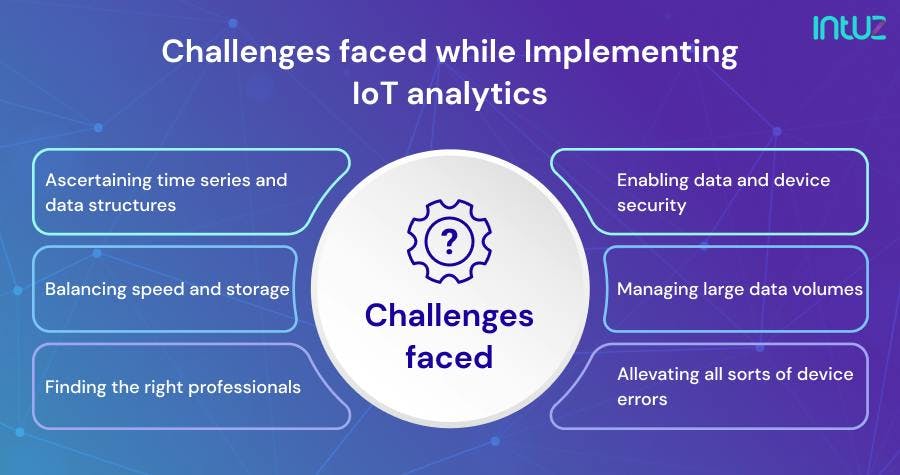
Challenges faced while implementing IoT analytics
Though there are many benefits associated with IoT analytics, it does not come without its fair share of implementation difficulties. Some significant challenges include:
1. Ascertaining time series and data structures
Sensors are an inseparable part of IoT analytics. They collect data and send it to a database where you can analyze what has happened. The reason you need this information is so that your tools work properly.
However, suppose there is no change in sensor readings over time. In that case, analysis becomes difficult because the sensors are not being influenced by anything causing fluctuations that would impact the overall results.
The sensors may still provide valuable insights into how an issue affects particular areas or industries without external factors constantly impacting the data across platforms.
2. Balancing speed and storage
The struggle to store data and process it quickly is a common problem for businesses. Scaling the use of IoT devices can be a headache, especially when historical information needs storing to make comparisons with the current events or actions taken on your part.
To store historical information on past transactions would require an unrealistic investment for any company with limited resources.
It means companies may not be able to store all their current records if they want to access them in real-time or make comparisons between them when new ones come along if they do not have the budget to support the infrastructure.
3. Finding the right professionals
Hiring for IoT analytics is problematic because it requires many different skill sets. A company needs to have several professionals on board, including developers, data scientists, and database specialists, to make sense of IoT efficiently. Depending on your business model, you may need other professionals to perform crucial tasks.
4. Enabling data and device security
IoT analytics architectures need to be secure as they are vulnerable to attacks from outsiders. If a hacker gains access to and uses the information from IoT devices, it can impact a company's decisions and hinder its operations.
It is imperative to protect data against such cyber attacks while maintaining integrity to protect customer privacy. However, these IoT analytics security systems should come at a low cost with easy implementation capabilities and offer protection against any potential threats.
Top IoT development tools & platforms with comparison [2022]
Learn More5. Managing large data volumes
IoT analytics is a process that begins with collecting and analyzing data, but there are several challenges to dealing with such massive data sets. It is difficult to process and store large volumes of data. No human being can manually do so.
Cloud computing solves the problem as it has virtually unlimited capacity for storing IoT records over time. It does not require as much processing power or bandwidth to maintain uninterrupted IoT logs throughout the lifecycle.
6. Alleviating all sorts of device errors
The data from your IoT device can be helpful only if it is available when needed. If a device loses connection or breakdowns in the field, the data collection process is disrupted. Network redundancy is helpful in such cases.
It ensures you have a duplicate infrastructure with alternate network devices and connections. These additional devices are installed to gather data through an alternate path in case of any failures of the primary network.
Layers of IoT analytics
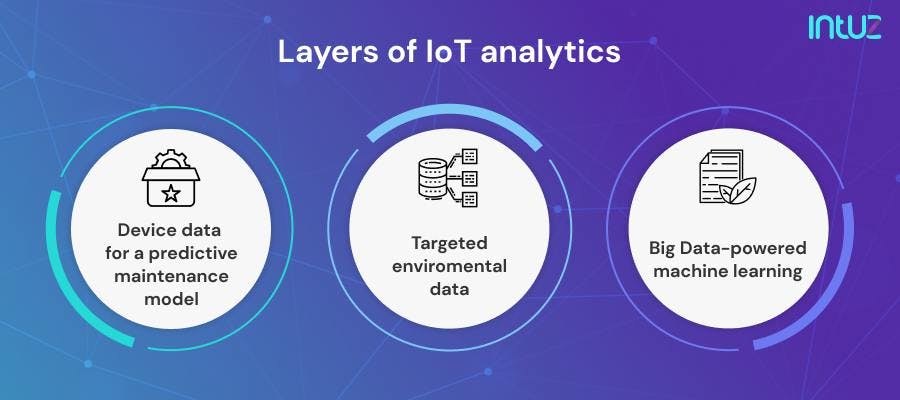
Layers of IoT analytics
IoT is quickly becoming a part of our everyday life, even though there are obstacles to the growth of the IoT analytics market. Extracting insights from varied sources, securing devices, and storing data might be some of the challenges. The key layers of IoT analytics are:
1. Device data for a predictive maintenance model
Today, many businesses use IoT sensors to monitor equipment in the field or on the factory floor. The data collected by these IoT devices are sent back and reviewed through an algorithm that generates alerts whenever an anomaly is detected - for instance - the machinery indicating the need for servicing or a part malfunctioning.
Companies can use the device data to identify connectivity issues and address them in real-time. A micro-mobility vendor might be managing thousands of connected scooters within an urban area. With the help of an IoT platform, they can monitor the connectivity data and receive alerts if there are any service interruptions or anomalies.
2. Targeted environmental data
IoT solutions use sensors to collect and analyze data about the activities around them. It can be anything - from temperature readings in an enclosed area and weather monitoring systems in cities to security surveillance cameras and medical telehealth devices.
The data from such sensors is sent to a cloud-based IoT platform, then analyzed to generate actionable insights by connecting them with third-party analytics software solutions or other enterprise systems.
3. Big Data-powered machine learning
With the recent advancements in technology, we can now collect more data than ever before. This has led to a new field of study known as Big data, which deals with large datasets.
The information is gathered from IoT sensors - functioning at various sources - such as during the online interactions with customers or agricultural equipment used throughout the fields.
Though some companies may look for specific data to identify a problem, the better way to use IoT data is by gathering as much of it as possible.
The large volumes of data can be used to power AI-embedded IoT analytics engines, which will help identify undetected issues and find different ways to fix them. Companies can use the data for forecasting and optimizing current processes.
For instance, vast volumes of data collected by telehealth monitors of a healthcare technology company may be used.
The constant data stream may help take immediate remedial action for the current situation. However, the remaining data can be made anonymous to comply with healthcare privacy laws.
AI-enabled software tools can use the data to extract insights about patient outcomes, device usage, and other details.
IIoT: predictive maintenance for machines
IIoT is a network that connects devices and sensors across large-scale sites. It finds applicability at production sites, manufacturing facilities, mining operations, and construction projects.
Deploying IIoT networks at a site allows it to be remotely monitored, optimize workplace safety and reduce costs in industries. It helps control operations across such as manufacturing or transportation. The factory manager can remotely monitor the functioning of every machine in real-time from a central location.
The arrangement helps in ensuring that no repair requirements and breakdowns go unnoticed. On the other hand, sensors on the assembly line or other equipment trigger an alert if a machine starts malfunctioning.
Timely repairs by implementing a dataset content version reduce accidents and downtime and allow businesses to keep their expenses on the down-low. Let us look at how AI-embedded IoT analytics is making a splash in the IIoT ecosystem:
1. Smart cities
IoT sensors can be placed in key places such as traffic lights, public transportation stations, and vehicles in a typical city. The data generated by these devices can be analyzed to identify problems and improve decision-making processes.
For instance, city managers can use sensors in an urban parking garage to track the number of cars entering and exiting. The data can also display free slots in real-time, thereby making the parking process convenient for drivers.
Since all collected data is time-stamped, city managers can use it to analyze patterns. They can predict the peak times by studying the trend. Decisions can be made to free up additional space at the time identified when the garage is likely to be full.
If the frequency is high, the manager can decide to build another structure to accommodate the excess vehicles. That is how easy IoT analytics makes the job of people.
2. Smart agriculture
IoT has proven to be extremely useful in agriculture. Sensors can be installed to monitor crucial aspects such as crop health, soil quality, and livestock conditions. These sensors send back data periodically, which helps farmers manage their crops or herds more effectively.
Remote monitoring with the help of IoT sensors allows agricultural enterprises to improve yield by monitoring key indicators such as temperature, soil moisture levels, pests, and weather conditions in real-time.
Based on these alerts, farmers can make decisions to take corrective action. In addition, they can utilize predictive analytics to forecast the resources needed for each stage from seedling through harvest.
Connected field machinery can work more efficiently by tapping into the potential of IoT analytics. It uses information derived from sensors that measure weather, time, altitude, location, and other parameters.
These factors are analyzed for the machine or system used to set up farming optimally or food production activities based on local environmental conditions.
For instance, an irrigation system can be optimized using weather reports to sprinkle only the required amount of water. This saves water and does not hamper crop health.
AWS IoT Analytics is the perfect solution for analyzing your entire data set. It can automatically enrich device information with contextual metadata using sources such as global positioning systems (GPS) and environmental conditions like temperature and altitude to provide users an unprecedented insight.
The more information you have about the deployment zone, the better decisions can be made for both operators and equipment.
For example, with AWS IoT Analytics, you can analyze moisture sensor data and forecasted rainfall in your region. It helps optimize watering schedules delivered via automated irrigation systems across large fields of crops.
3. Healthcare
Healthcare is one of the most popular industries to explore IoT devices for various implications. Bluetooth technology is utilized in hearing aids, blood pressure monitors, and alarm systems. This data is valuable when creating newer or better healthcare systems. The technology helps gain insight into how people can benefit from these devices and use them effectively.
IoT Device Management: Importance, Challenges, Solutions
Learn MoreAppropriate network connectivity for IoT analytics
The connectivity needs of your descriptive analytics platform can vary depending on the type of analysis you want to perform. High-throughput streaming requires radio access technology that supports higher rates. However, for triggered check-ins, low-power solutions might be better. Some options to consider include:
1. Low throughput: NB-IoT, Cat-M1, and Cat-1
NB-IoT, Cat-M1, and Cat-1 are LTE standards built to support typical IoT applications such as industrial monitors, agricultural sensors, HVAC control, and so on.
Low-power wide-area network (LPWAN) technologies such as Narrow-band IoT (NB-IoT) and Cat-M1 are created by 3GPP as a part of Release 13 of the LTE standard. They are low-cost solutions ideal for building health monitors, asset tracking systems, and smart meters.
NB-IoT has an upload and download speed of 1.6 Mbps and a latency of 10 seconds, while Cat-M1 is comparatively faster with 1 Mbps upload and download speeds and 10 to 15 milliseconds latency.
Widely used in smart home alarms, retail kiosks, point-of-sale terminals, vehicle telematics, and video surveillance, CAT-1 provides a short-range signal. Though it consumes more power, it supports IoT devices with low and medium bandwidth needs.
2. Higher throughput: Cat-4 or Cat-6
Designed to support much higher throughput, these radio technologies are suitable for seamlessly streaming video, voice, or other data across devices. Supporting precise real-time monitoring, Cat-4 has a download speed of 150 Mbps and an upload speed of 50 Mbps. Whereas, Cat-6 can support downloads up to 300 Mbps with a 50 Mbps upload speed.
IoT analytics tools: AWS takes the cake
AWS IoT Analytics is a fully-managed IoT analytics solution that businesses can use for performing sophisticated analyses on massive volumes of data gathered from connected IoT devices. They do not have to worry about the cost or complexity of building an IoT analytics platform.
Besides being the easiest way to run analytics on IoT data, AWS IoT Analytics offers you insights to make accurate decisions for various IoT apps and ML use cases.
IoT data is a crucial component of modern analytics, but it is often unstructured and comes from devices that report relatively noisy processes such as temperature or sound. Traditionally analyzing such data sets is nearly impossible.
It could take a significant amount of time to clean up the errors caused by latencies, corrupt message attributes, and false alarms - making things difficult for Business Intelligence (BI) tools designed primarily with structured databases at their disposal.
IoT data can be meaningful only when connected to third-party sources. Streamlining information from all sources enables the efficient use of resources to maximize output.
The AWS IoT Analytics service makes it easy to analyze data from your IoT devices by automating the problematic steps of filtering, transforming, and enriching them before storing them in a time-series database for further analysis.
Configure this tool with features you need, like only collecting relevant information about each device or processing all fields simultaneously along with other device-specific metadata.
AWS IoT Analytics enables users to stay updated with trends and make informed decisions based on their needs. The built-in SQL query engine lets you analyze your data by running ad hoc or scheduled queries.
AWS IoT Analytics offers pre-built models for everyday use cases of IoT, allowing easy deployment of ML. By packaging your custom analysis in a container, you can quickly execute it on AWS IoT Analytics.
The service saves time by automating the execution of analyses created with Jupyter Notebook or other tools such as Matlab/Octave so that they are always available when needed. It operationalizes analyses to support petabytes of data from IoT devices while scaling automatically.
Benefits of AWS IoT Analytics
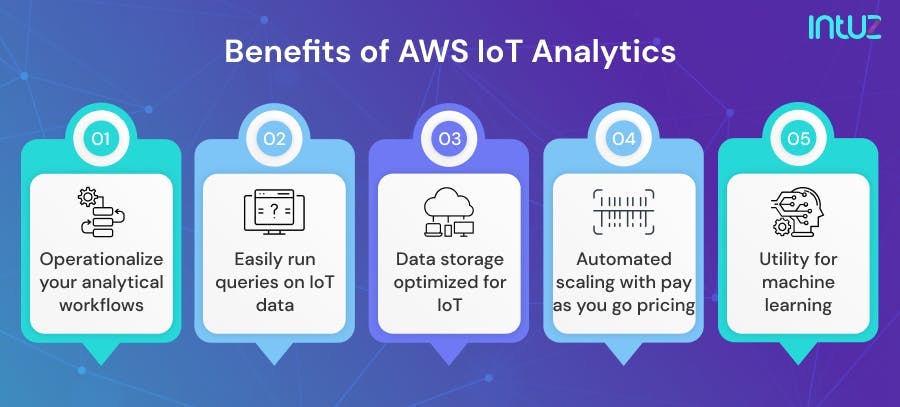
Benefits of AWS IoT Analytics
With AWS IoT Analytics, you can analyze millions of devices from a single dashboard without managing hardware or infrastructure. You can also build fast and responsive IoT applications. Here are the benefits of AWS IoT Analytics:
1. Operationalize your analytical workflows
The power of AWS IoT Analytics is in its ability to automate your analysis when and where you need it. You can use any code that runs on a computer, including external tools such as Matlab or Octave-to generate operational insights, so your focus does not have to be centered around programming.
2. Easily run queries on IoT data
With AWS IoT Analytics, you can extract data from your sensors and use standard SQL queries to remove data from the data store. This service also provides non-overlapping time windows for analysis that are perfect for performing analysis on incremental information. It allows you to scan only the required data to lower costs and improve analysis efficiency.
3. Data storage optimized for IoT
The AWS IoT Analytics service is a breakthrough in data management for IoT. By using an optimized time-series data store, you can achieve fast query response times on any device from anywhere with access to the resource. The raw data is securely stored automatically for later processing or reprocessing to be used for other cases.
4. Automated scaling with pay as you go pricing
AWS IoT Analytics is a service that can analyze your entire fleet of connected IoT devices without you having to manage hardware or infrastructure. With this fully managed and pay-as-go platform, it is easy for you to make datastore size adjustments based on need.
This ensures there will always be enough capacity available when needed while you pay only for the resources in the application.
5. Utility for machine learning
Use machine learning to get a health score for each device in your fleet. With AWS IoT Analytics, connecting the data from any number of devices running on Amazon Web Services, Inc. (AWS) is easy and straightforward.
The console will automatically extract information about their behavior using trained models, while you do not need to manage infrastructure or install anything locally onto individual computers.
With just the click of a button, you can also package your code into an executable container image and execute that on AWS IoT Analytics as needed. This will allow manufacturers to detect customers needing assistance for maintenance and alert them accordingly.
Prepares your IoT data for analysis
The AWS IoT Analytics service monitors sensors, data preparation, and time-series analyses. It enables insights into how your devices are being used so you can make better decisions about their future maintenance needs or when to replace them with new models that will be more efficient at performing tasks.
Integrating AWS IoT Analytics with the recently released Core service provides a smoother way to ingest data from connected devices. With this, users can clean any false readings and fill gaps in their informational needs while performing mathematical transformations on unprocessed messages for better accuracy.
The data is ingested into AWS IoT Analytics, which can process it using conditional statements and filter information only to show what you want. It is also possible for the software to programmatically query relevant AWS IoT registry records with just one click.
AWS Lambda functions can enrich your device data from external sources like the Weather Service, HERE Maps Salesforce, or Amazon Simple Storage Service.
Over to you
IoT is projected to grow exponentially as 47% of the organizations worldwide plan to increase their investments in IoT. Data continues to stream in from these IoT devices, so its volume will go up over time.
It is, therefore, important for companies to gauge the performance of devices in real-time and have the power to use the data for generating insights.
IoT analytics can unlock the true potential of IoT data, opening up several opportunities a company could leverage to get ahead of its competitors. It helps analyze and visualize the network traffic from different aspects, which could be beneficial for the growth of your business.
If you are looking for a helping hand in IoT analytics, you can always count on Intuz, an IoT development company. We have worked on many IoT projects and can build a robust IoT analysis platform. Contact us to find out more.
